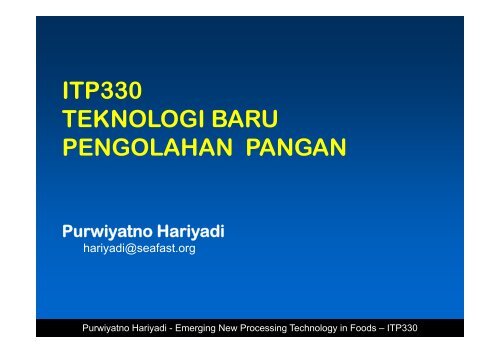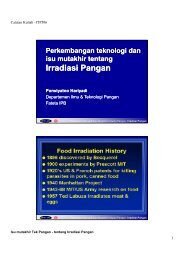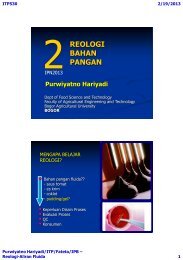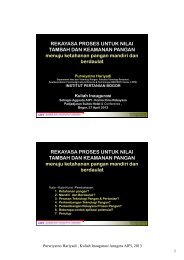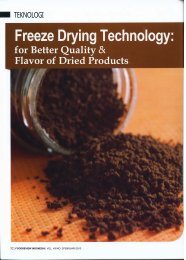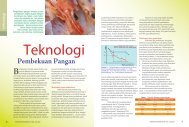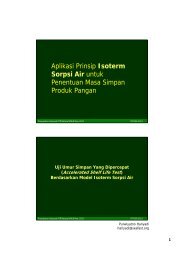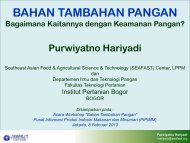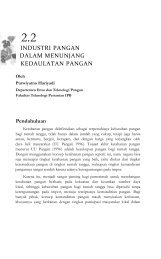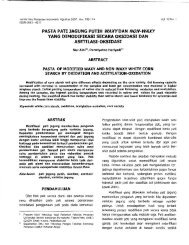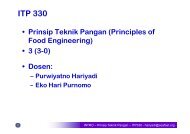ITP330-Emerging New Food Processing Technology
ITP330-Emerging New Food Processing Technology
ITP330-Emerging New Food Processing Technology
You also want an ePaper? Increase the reach of your titles
YUMPU automatically turns print PDFs into web optimized ePapers that Google loves.
<strong>ITP330</strong><br />
TEKNOLOGI BARU<br />
PENGOLAHAN PANGAN<br />
Purwiyatno Hariyadi<br />
hariyadi@seafast.org<br />
Purwiyatno Hariyadi - <strong>Emerging</strong> <strong>New</strong> <strong>Processing</strong> <strong>Technology</strong> in <strong>Food</strong>s – <strong>ITP330</strong>
History of <strong>Food</strong> Process Engineering<br />
ww<br />
www.ift.org<br />
Ref.: Original C.J.K. Henry, Proc. Nutrition Soc 56:855-863, 1997;<br />
2011 IFIC Communication Summit – Dave Schmidt, “Alliance to Feed the Future, 24 May 2011<br />
)<br />
(billions<br />
5<br />
4<br />
1976<br />
Wor rld’s Pop pulation<br />
3<br />
2<br />
1<br />
1850<br />
Hunter-Gatherer Agricultural Industrial<br />
1930<br />
4 million<br />
10 000<br />
Years ago<br />
Years ago 1800 1900 2000<br />
1960<br />
Introduction of<br />
<strong>Food</strong> technology<br />
Purwiyatno Hariyadi - <strong>Emerging</strong> <strong>New</strong> <strong>Processing</strong> <strong>Technology</strong> in <strong>Food</strong>s – <strong>ITP330</strong>
History of <strong>Food</strong> Process Engineering<br />
)<br />
(billions<br />
Wor rld’s Pop pulation<br />
5<br />
4<br />
3<br />
2<br />
1<br />
• Fiber crates<br />
• Cellulose packaging<br />
• Gable-top, waxed milk<br />
cartons<br />
• Sliced bread<br />
• Jell-O<br />
• Regulations e.g. <strong>Food</strong>, Drug,<br />
and Cosmetic Act<br />
1930s<br />
1850<br />
Hunter-Gatherer Agricultural Industrial<br />
1930<br />
4 million<br />
10 000<br />
Years ago<br />
Years ago 1800 1900 2000<br />
1976<br />
1960<br />
Introduction of<br />
<strong>Food</strong> technology<br />
Purwiyatno Hariyadi - <strong>Emerging</strong> <strong>New</strong> <strong>Processing</strong> <strong>Technology</strong> in <strong>Food</strong>s – <strong>ITP330</strong>
History of <strong>Food</strong> Process Engineering<br />
•Automation<br />
)<br />
(billions<br />
5<br />
4<br />
•Mass production<br />
•Frozen foods<br />
•Vending machines<br />
1976<br />
Wor rld’s Pop pulation<br />
3<br />
2<br />
1<br />
1940s<br />
1850<br />
Hunter-Gatherer Agricultural Industrial<br />
1930<br />
4 million<br />
10 000<br />
Years ago<br />
Years ago 1800 1900 2000<br />
1960<br />
Introduction of<br />
<strong>Food</strong> technology<br />
Purwiyatno Hariyadi - <strong>Emerging</strong> <strong>New</strong> <strong>Processing</strong> <strong>Technology</strong> in <strong>Food</strong>s – <strong>ITP330</strong>
History of <strong>Food</strong> Process Engineering<br />
)<br />
(billions<br />
Wor rld’s Pop pulation<br />
5<br />
4<br />
3<br />
2<br />
1<br />
•Frozen dinners<br />
•Foreign g foods<br />
•<strong>Food</strong> for bomb shelters<br />
•Frozen, ready-to-eat bakery<br />
goods<br />
•Targeted markets<br />
•Controlled-atmosphere<br />
packaging<br />
1950s<br />
1850<br />
Hunter-Gatherer Agricultural Industrial<br />
1930<br />
4 million<br />
10 000<br />
Years ago<br />
Years ago 1800 1900 2000<br />
1976<br />
1960<br />
Introduction of<br />
<strong>Food</strong> technology<br />
Purwiyatno Hariyadi - <strong>Emerging</strong> <strong>New</strong> <strong>Processing</strong> <strong>Technology</strong> in <strong>Food</strong>s – <strong>ITP330</strong>
History of <strong>Food</strong> Process Engineering<br />
•Diet foods<br />
•Process P control computers<br />
)<br />
(billions<br />
5<br />
4<br />
•Clean-in-place<br />
•Aseptic canning<br />
•Drying improvements<br />
1976<br />
Wor rld’s Pop pulation<br />
3<br />
2<br />
1<br />
1960s<br />
1850<br />
Hunter-Gatherer Agricultural Industrial<br />
1930<br />
4 million<br />
10 000<br />
Years ago<br />
Years ago 1800 1900 2000<br />
1960<br />
Introduction of<br />
<strong>Food</strong> technology<br />
Purwiyatno Hariyadi - <strong>Emerging</strong> <strong>New</strong> <strong>Processing</strong> <strong>Technology</strong> in <strong>Food</strong>s – <strong>ITP330</strong>
History of <strong>Food</strong> Process Engineering<br />
)<br />
(billions<br />
Wor rld’s Pop pulation<br />
5<br />
4<br />
3<br />
2<br />
1<br />
•Energy efficiency<br />
•Water/waste W t / t utilization<br />
•Membrane processing<br />
•Health/organic foods<br />
•Environmentally robust<br />
computers<br />
1970s<br />
1850<br />
Hunter-Gatherer Agricultural Industrial<br />
1930<br />
4 million<br />
10 000<br />
Years ago<br />
Years ago 1800 1900 2000<br />
1976<br />
1960<br />
Introduction of<br />
<strong>Food</strong> technology<br />
Purwiyatno Hariyadi - <strong>Emerging</strong> <strong>New</strong> <strong>Processing</strong> <strong>Technology</strong> in <strong>Food</strong>s – <strong>ITP330</strong>
History of <strong>Food</strong> Process Engineering<br />
•Dechemicalization<br />
•Automation<br />
)<br />
(billions<br />
5<br />
4<br />
•Aseptic processing<br />
•Irradiation<br />
•Packaging<br />
1976<br />
Wor rld’s Pop pulation<br />
3<br />
2<br />
1<br />
1980s<br />
1850<br />
Hunter-Gatherer Agricultural Industrial<br />
1930<br />
4 million<br />
10 000<br />
Years ago<br />
Years ago 1800 1900 2000<br />
1960<br />
Introduction of<br />
<strong>Food</strong> technology<br />
Purwiyatno Hariyadi - <strong>Emerging</strong> <strong>New</strong> <strong>Processing</strong> <strong>Technology</strong> in <strong>Food</strong>s – <strong>ITP330</strong>
History of <strong>Food</strong> Process Engineering<br />
•Intelligent Packaging<br />
•Low Carb<br />
)<br />
(billions<br />
5<br />
4<br />
•Sachet Packaging<br />
•Functional <strong>Food</strong>s<br />
1976<br />
Wor rld’s Pop pulation<br />
3<br />
2<br />
1<br />
1990s<br />
1850<br />
Hunter-Gatherer Agricultural Industrial<br />
1930<br />
4 million<br />
10 000<br />
Years ago<br />
Years ago 1800 1900 2000<br />
1960<br />
Introduction of<br />
<strong>Food</strong> technology<br />
Purwiyatno Hariyadi - <strong>Emerging</strong> <strong>New</strong> <strong>Processing</strong> <strong>Technology</strong> in <strong>Food</strong>s – <strong>ITP330</strong>
Driving Force of <strong>Food</strong> Science/<strong>Food</strong> <strong>Technology</strong><br />
+<br />
•Safe<br />
•Wholesome<br />
•Nutritious<br />
•“Functional”<br />
•Green”<br />
)<br />
(billions<br />
Wor rld’s Pop pulation<br />
5<br />
4<br />
3<br />
2<br />
1<br />
•Cheap<br />
•Abundant<br />
•Available<br />
1850<br />
Hunter-Gatherer Agricultural Industrial<br />
1930<br />
4 million<br />
10 000<br />
Years ago<br />
Years ago 1800 1900 2000<br />
1976<br />
1960<br />
Introduction of<br />
<strong>Food</strong> technology<br />
Purwiyatno Hariyadi - <strong>Emerging</strong> <strong>New</strong> <strong>Processing</strong> <strong>Technology</strong> in <strong>Food</strong>s – <strong>ITP330</strong>
Driving Force of <strong>Food</strong> Science/<strong>Food</strong> <strong>Technology</strong><br />
+<br />
•Safe<br />
•Wholesome<br />
•Nutritious<br />
•“Functional”<br />
•Green”<br />
•Cheap<br />
•Abundant<br />
•Available<br />
Purwiyatno Hariyadi - <strong>Emerging</strong> <strong>New</strong> <strong>Processing</strong> <strong>Technology</strong> in <strong>Food</strong>s – <strong>ITP330</strong>
Driving Force of <strong>Food</strong> Science/<strong>Food</strong> <strong>Technology</strong><br />
•Alternatives<br />
<strong>Food</strong> <strong>Processing</strong><br />
<strong>Technology</strong><br />
<strong>Food</strong> <strong>Technology</strong><br />
Providing better value of foods<br />
Purwiyatno Hariyadi - <strong>Emerging</strong> <strong>New</strong> <strong>Processing</strong> <strong>Technology</strong> in <strong>Food</strong>s – <strong>ITP330</strong>
http://www.fda.gov/<strong>Food</strong>/ScienceResearch/ResearchAreas/SafePracticesfor<strong>Food</strong>Processes/ucm100158.htm<br />
Purwiyatno Hariyadi - <strong>Emerging</strong> <strong>New</strong> <strong>Processing</strong> <strong>Technology</strong> in <strong>Food</strong>s – <strong>ITP330</strong>
<strong>Emerging</strong> <strong>Processing</strong> Technologies<br />
• Microwave and Radio Frequency<br />
• Ohmic and Inductive Heating<br />
• High Pressure <strong>Processing</strong><br />
• Pulsed Electric Field<br />
• High Voltage Arc Discharge<br />
• Pulsed Light<br />
• Ultraviolet Light<br />
• Ultrasound<br />
• X-Rays<br />
http://www.fda.gov/<strong>Food</strong>/ScienceResearch/ResearchAreas/SafePracticesfor<strong>Food</strong>Processes/ucm100158.htm<br />
Purwiyatno Hariyadi - <strong>Emerging</strong> <strong>New</strong> <strong>Processing</strong> <strong>Technology</strong> in <strong>Food</strong>s – <strong>ITP330</strong>
Status of the Report on Technologies (1)<br />
FDA Questions<br />
<strong>Technology</strong><br />
Ohmic Heating<br />
Microwave<br />
Process Description Well described Well described<br />
Mechanism of Activation Well described Well described<br />
Cii Critical lFactors and<br />
Well described<br />
d Well described<br />
d<br />
Quantification Hard to predict cold zone Hard to predict cold zone<br />
Process deviations<br />
As in conventional thermal<br />
As in conventional thermal<br />
processing<br />
processing<br />
Organizms of concern<br />
As in conventional thermal<br />
processing<br />
As in conventional thermal<br />
processing<br />
Indicator organizms<br />
As in conventional thermal As in conventional thermal<br />
processing<br />
processing<br />
Main reseacrh need Prediction of cold zone Prediction of cold zone<br />
and Uniformity of heating<br />
Purwiyatno Hariyadi - <strong>Emerging</strong> <strong>New</strong> <strong>Processing</strong> <strong>Technology</strong> in <strong>Food</strong>s – <strong>ITP330</strong>
Status of the Report on Technologies (2)<br />
FDA Questions<br />
Ultra Sound<br />
<strong>Technology</strong><br />
High Pressure<br />
Process Description Well described Well described<br />
Mechanism of Activation Described Well described<br />
Cii Critical lFactors and<br />
Suggested<br />
Well described<br />
d<br />
Quantification<br />
Proposed Models<br />
Process deviations Not identified 1 Well described<br />
Organizms of concern Not identified 1 Identified<br />
Indicator organizms Not identified 2 Suggested<br />
Main reseacrh need<br />
Multiple combination with<br />
other technologies<br />
Validation kinetics<br />
Influence of synergistic<br />
processing conditions<br />
1.<br />
Lack of critical process factors quantification does not permit suggested responses to process<br />
deviations<br />
2.<br />
Must identify pathogen of concern before indicators are finalized<br />
Purwiyatno Hariyadi - <strong>Emerging</strong> <strong>New</strong> <strong>Processing</strong> <strong>Technology</strong> in <strong>Food</strong>s – <strong>ITP330</strong>
Status of the Report on Technologies (3)<br />
Purwiyatno Hariyadi - <strong>Emerging</strong> <strong>New</strong> <strong>Processing</strong> <strong>Technology</strong> in <strong>Food</strong>s – <strong>ITP330</strong>
PENGGUNAAN GEL MIKRO (MICROWAVE/MW)<br />
UNTUK KEPERLUAN INDUSTRI :<br />
Gelombang mikro<br />
Berdekatan dan<br />
Tumpang tindih<br />
Dengan kisaran<br />
Gelombang radio<br />
Berpeluang<br />
mengganggu<br />
proses<br />
komunikasi<br />
Penggunaan MW<br />
perlu diatur<br />
oleh badan<br />
yang berwenang,<br />
Mis.<br />
Di AS : Federal Communication Commission<br />
memperbolehkan pemakaian 4 frekuensi MW :<br />
22150, 5800, 2450 dan 915 MHz<br />
Paling banyak : 915 dan 2450 MHz<br />
Inggris : 915 dan 2450 MHz<br />
Jerman : 27,12; 433,92 dan 2450 MHz<br />
Eropa Timur: 2375 MHz<br />
Purwiyatno Hariyadi - <strong>Emerging</strong> <strong>New</strong> <strong>Processing</strong> <strong>Technology</strong> in <strong>Food</strong>s – <strong>ITP330</strong>
PEMANASAN DIELEKTRIK (& GEL MIKRO)<br />
dipantulkan oleh metal<br />
diserap (diubah menjadi panas) oleh dielektrik : internal heating<br />
(Molecular friction).<br />
Generator<br />
(Oscilator)<br />
Bahan<br />
pangan<br />
+/-<br />
+/-<br />
H<br />
δ+<br />
δ+<br />
H<br />
O<br />
δ-<br />
O<br />
δ-<br />
H<br />
δ+<br />
δ+<br />
H<br />
“Perub.<br />
Orientasi<br />
polarisasi”<br />
i”<br />
+ Ionic<br />
+<br />
displacement<br />
Purwiyatno Hariyadi - <strong>Emerging</strong> <strong>New</strong> <strong>Processing</strong> <strong>Technology</strong> in <strong>Food</strong>s – <strong>ITP330</strong>
Listrik<br />
Konversi Energi<br />
Panas<br />
P = 2π(ε o )( ε’) tan δE 2 f<br />
P = 5.56x1056x10 -13 ( ε’) ε ) tan δE 2 f<br />
P = jumlah panas yang diproduksi per satuan volume [=] W/m 3<br />
ε o = permitivity of free space<br />
ε’ = konstanta dielektrik<br />
(sifat fisik bahan yang berhubungan<br />
dengan polaritas atau Σ dipole)<br />
δ = loss angle<br />
E = kekuatan medan listrik [=] volts/m<br />
f = frekuensi (hz, s -1 )<br />
ε’ tan δ = ε’’ = loss factor<br />
Purwiyatno Hariyadi - <strong>Emerging</strong> <strong>New</strong> <strong>Processing</strong> <strong>Technology</strong> in <strong>Food</strong>s – <strong>ITP330</strong>
LOSS FACTOR<br />
∈ε” = f (SUHU, FREKUENSI)<br />
35<br />
30<br />
25<br />
20<br />
15<br />
10<br />
5<br />
0<br />
Cooked<br />
carrots<br />
H 2 O<br />
-20 0 20 40 60<br />
Mashed<br />
Potatoes<br />
160 450 MHz<br />
140<br />
120<br />
100<br />
80<br />
60<br />
40<br />
20<br />
0<br />
-20 20 40 60<br />
900 MHz<br />
2700 MHz<br />
SUHU ( o C) SUHU ( o C)<br />
Purwiyatno Hariyadi - <strong>Emerging</strong> <strong>New</strong> <strong>Processing</strong> <strong>Technology</strong> in <strong>Food</strong>s – <strong>ITP330</strong>
DAYA PENETRASI GEL MIKRO = d<br />
d<br />
=<br />
2π<br />
λ<br />
ε'<br />
o<br />
tanδ<br />
λ o = panjang gelombang<br />
Kedalaman penetrasi, d[=] cm<br />
Kadar air ε’ 915 MHz 2450 MHz<br />
tinggi 15 8,4 3,1<br />
sedang 4 11,7 4,4<br />
rendah 1,5 22,1 8,2<br />
Purwiyatno Hariyadi - <strong>Emerging</strong> <strong>New</strong> <strong>Processing</strong> <strong>Technology</strong> in <strong>Food</strong>s – <strong>ITP330</strong>
PENINGKATAN SUHU DALAM PRODUK<br />
Jumlah panas yang diperlukan<br />
untuk meningkatkan suhu produk sebesar ΔT<br />
Q = mc ΔT<br />
Q = ρVcΔT atau<br />
ΔT= Q/ρVc<br />
dimana V = volume<br />
Jumlah panas yang diproduksi oleh pemanasan gel mikro :<br />
Q = PVΔt<br />
Q = (5.56 x 10 -13 ε”E 2 f)VΔt<br />
Jadi, ε”<br />
ΔT = 5.56 x 10 -13<br />
ρc<br />
E2 f Δt<br />
untuk pemanasan gel mikro yang sama,<br />
ΔT = ≈ ε” = f (Komponen bahan pangan)<br />
ρc<br />
homogenitas pemanasan = homogenitas bahan pangan<br />
Purwiyatno Hariyadi - <strong>Emerging</strong> <strong>New</strong> <strong>Processing</strong> <strong>Technology</strong> in <strong>Food</strong>s – <strong>ITP330</strong>
APLIKASI PEMANASAN GEL. MIKRO (UMUM):<br />
•Rumah tangga : microwave oven<br />
•Komersial<br />
4Pemanasan tanpa merubah sifat-sifat dasar produk :<br />
thawing & defrosing (tempering)<br />
4Pemanasan dengan merubah sifat-sifat dasar produk :<br />
Pengembangan adonan & pemanggangan<br />
Pemblansiran buah/sayuran : inativasi enzim<br />
Pemasakan (cooking)<br />
Roasting (untuk kacang-kacangan)<br />
4Pengeringan : Dehidrasi pada tekanan normal<br />
Dehidrasi pada tekanan vakum<br />
4Inaktivasi Mikroba :<br />
Sterilisasi & Pasteurisasi (kurang sukses ! :<br />
masih dalam penelitian!)<br />
Purwiyatno Hariyadi - <strong>Emerging</strong> <strong>New</strong> <strong>Processing</strong> <strong>Technology</strong> in <strong>Food</strong>s – <strong>ITP330</strong>
APLIKASI PEMANASAN GEL. MIKRO PADA PROSES<br />
PEMANGGANGAN<br />
Utama : ~ membantu proses pengeringan lanjut<br />
Proses pemanggangan dimulai dengan oven tradisional (mengg.<br />
udara panas) :<br />
Efektif untuk produk dengan kadar air tinggi<br />
Dengan semakin menurunnya kadar air :<br />
efektifitas oven menurun<br />
case hardening?!<br />
Pengeringan/pemanggangan g g p gg g selanjutnya :<br />
oven gel. Mikro<br />
mengeringkan bag dalam (tanpa “overcooked” di<br />
permukaan)<br />
Purwiyatno Hariyadi - <strong>Emerging</strong> <strong>New</strong> <strong>Processing</strong> <strong>Technology</strong> in <strong>Food</strong>s – <strong>ITP330</strong>
APLIKASI PEMANASAN GEL. MIKRO PADA PROSES<br />
THAWING :<br />
☺ Konduktivitas panas air < konduktivitas panas es<br />
Proses pencairan : menurunkan proses pindah panas<br />
☺ Loss factor air > loss factor es<br />
Proses pencairan : menaikan kadar air dan loss factor<br />
>>mempercepat proses pemanasan<br />
☺ Problem : Pada bahan baku yang ukuran besar<br />
- proses pencairan tidak seragam<br />
- mengakibatkan overcooked pada bagian ttt<br />
Purwiyatno Hariyadi - <strong>Emerging</strong> <strong>New</strong> <strong>Processing</strong> <strong>Technology</strong> in <strong>Food</strong>s – <strong>ITP330</strong>
APLIKASI PEMANASAN GEL. MIKRO PADA PROSES<br />
DEFROSTING :<br />
Menaikan suhu produk beku: -20 o C menjadi -3 o C<br />
Untuk daging g dan mentega mempermudah penanganan (slicing)<br />
Minimum overcooked<br />
Cepat : .................... > daging dapat didefrost selama 10 menit<br />
(tradisional: beberapa hari pada cold room)<br />
Minimum perubahan phase<br />
Minimum drip loss (kehilangan karena penetesan)<br />
Mutu meningkat: lebih higienik, lebih cepat, dapat dilakukan di<br />
dalam box (pengemas)<br />
Ruang yang diperlukan sedikit<br />
Ekonomis<br />
Purwiyatno Hariyadi - <strong>Emerging</strong> <strong>New</strong> <strong>Processing</strong> <strong>Technology</strong> in <strong>Food</strong>s – <strong>ITP330</strong>
APLIKASI PEMANASAN GEL. MIKRO PADA PROSES<br />
DEHIDRASI :<br />
VS. PEMANASAN TRADISIONAL/UDARA PANAS :<br />
Pindah panas turun :<br />
thermal conductivity turun pada bahan pangan kering<br />
Semakin lama waktu pengeringan mutu sensori dan mutu gizi<br />
turun<br />
Oksidasi tinggi : mengakibatkan warna dan vitamin menurun.<br />
Untuk produk dengan kadar pufa tinggi, terjadi ketengikan<br />
Case hardening : perubahan karakteristik permukaan<br />
>> keras, susah ditembus oleh panas/uap<br />
air (kualitas produk menurun)<br />
Purwiyatno Hariyadi - <strong>Emerging</strong> <strong>New</strong> <strong>Processing</strong> <strong>Technology</strong> in <strong>Food</strong>s – <strong>ITP330</strong>
APLIKASI PEMANASAN GEL. MIKRO PADA PROSES<br />
DEHIDRASI :<br />
VS. PEMANASAN GELOMBANG MIKRO :<br />
Memanaskan k bahan dari dalam :<br />
Tidak ada masalah ttg konduktivitas panas<br />
Tidak memanaskan udara : mrengurangi ksidasi rendah<br />
Tidak terjadi case hardening<br />
(pindah massa/uap air ......... > lancar)<br />
Umumnya dipakai untuk mengeringkan semi/partly dried foods,<br />
dimana gel. Mikro akan tetap memanaskan daerah yang masih<br />
basah, tanpa mempengaruhi daerah/bagian yang sudah kering.<br />
Mahal<br />
Purwiyatno Hariyadi - <strong>Emerging</strong> <strong>New</strong> <strong>Processing</strong> <strong>Technology</strong> in <strong>Food</strong>s – <strong>ITP330</strong>
APLIKASI PEMANASAN GEL. MIKRO : LAIN-LAIN<br />
Masih dalam taraf penelitian:<br />
Blansir, Pasteurisasi, i Sterilisasi<br />
i<br />
PENGARUH GELOMBANG MIKRO TERHADAP BAHAN PANGAN :<br />
tidak ada pengaruh langsung pada mikroorganisme<br />
waktu proses menurun<br />
retensi gizi lebih baik (prinsip HTST)<br />
Purwiyatno Hariyadi - <strong>Emerging</strong> <strong>New</strong> <strong>Processing</strong> <strong>Technology</strong> in <strong>Food</strong>s – <strong>ITP330</strong>
PEMANASAN OHMIC<br />
elektroda<br />
BAHAN<br />
S Power<br />
Supply<br />
P = I 2 R<br />
P : laju jumlah panas yang diproduksi<br />
per satuan volume (W.m - 3 )<br />
P = I 2 k<br />
-1<br />
e E : kekuatan medan listrik (Volt cm - 1 )<br />
I = k k : konduktivitas listrik (ohm - 1 /m , e EL -1<br />
e S/m)<br />
I : densitas arus listrik (amps/m 2 )<br />
R : tahanan listrik (ohm - 1 )<br />
- kecepatan pemanasan tergantung t pada nilai i k e bahan pangan<br />
-k e bahan pangan =f(kadar air, garam ionik dan asam)<br />
-k e bahan pangan cair >> k e bahan padat<br />
- minyak dan lemak mempunyai nilai k e sangat rendah<br />
Purwiyatno Hariyadi - <strong>Emerging</strong> <strong>New</strong> <strong>Processing</strong> <strong>Technology</strong> in <strong>Food</strong>s – <strong>ITP330</strong>
Arah perambatan panas, Q<br />
Q(r)<br />
T<br />
−<br />
= Pr<br />
2<br />
T<br />
0<br />
=<br />
2<br />
Pr<br />
4k<br />
⎡<br />
⎢<br />
1 −<br />
⎣⎢<br />
⎛<br />
⎜<br />
⎝<br />
r<br />
R<br />
k = konduktivitas panas<br />
⎞<br />
⎟<br />
⎠<br />
2<br />
⎤<br />
⎥<br />
⎥⎦<br />
Kenaikan suhu maksimum<br />
T −<br />
max T =<br />
o<br />
Kenaikan suhu rata-rata<br />
T<br />
−<br />
T<br />
0 =<br />
PR<br />
4k<br />
PR<br />
2<br />
8k<br />
2<br />
Purwiyatno Hariyadi - <strong>Emerging</strong> <strong>New</strong> <strong>Processing</strong> <strong>Technology</strong> in <strong>Food</strong>s – <strong>ITP330</strong>
Contoh :<br />
Sebuah bahan berbentuk silinder dengan diameter 2R dan panjang<br />
L. Berapa Δ voltase (E) yang perlu diberikan supaya terjadi<br />
peningkatan suhu di pusat bahan sebesar (T max -T 0 ) o C, dimana suhu<br />
awal = T 0 .<br />
T −<br />
max T =<br />
PR<br />
Jawab :<br />
max 0<br />
Gunakan<br />
4k<br />
2<br />
persamaan<br />
I R<br />
peningkatan suhu<br />
T −<br />
max T =<br />
0<br />
T<br />
, I =<br />
max 4k e<br />
k<br />
max<br />
−<br />
Jadi,<br />
⎛<br />
E = 2⎜<br />
⎝<br />
T<br />
0<br />
L<br />
R<br />
=<br />
⎞<br />
⎟<br />
⎠<br />
2<br />
2<br />
2<br />
⎛ keE<br />
⎞<br />
⎜ ⎟ R<br />
⎝<br />
L<br />
⎠<br />
4k k<br />
k<br />
k<br />
T<br />
e<br />
2<br />
keE<br />
L<br />
⎛<br />
=<br />
⎜<br />
⎝<br />
T<br />
(T −<br />
0<br />
max<br />
2<br />
E<br />
R<br />
2<br />
4L<br />
Purwiyatno Hariyadi - <strong>Emerging</strong> <strong>New</strong> <strong>Processing</strong> <strong>Technology</strong> in <strong>Food</strong>s – <strong>ITP330</strong><br />
e<br />
0<br />
T<br />
0<br />
)<br />
2<br />
⎞<br />
⎛<br />
⎟⎜<br />
⎠⎝<br />
k<br />
k<br />
e<br />
⎞<br />
⎟<br />
⎠
PERBANDINGAN ANTARA PEMANASAN GEL MIKRO DAN OHMIC<br />
Kriteria<br />
Pemanasan<br />
Gel Mikro<br />
Pemanasan<br />
Ohmic<br />
Konduktivitas it listrik ik 0254 0.25-4 0.005-1.2<br />
005 12<br />
(siemen/m)<br />
Generasi Panas untuk<br />
medan listrik 20 V/m 1-1616 0.02-5<br />
(W/cm 3 )<br />
Kenaikan suhu 0.25-4*<br />
0.004-1.2*<br />
( o C/sec)<br />
* kenaikan suhu di permukaan kaleng pada proses pemanasan<br />
retort adalah sekitar 0.2 o C/sec<br />
Purwiyatno Hariyadi - <strong>Emerging</strong> <strong>New</strong> <strong>Processing</strong> <strong>Technology</strong> in <strong>Food</strong>s – <strong>ITP330</strong>
PEMANASAN OHMIC VS GELOMBANG MIKRO<br />
Mirip dengan pemanasan gel. Mikro :<br />
Konversi enegi listrik ik menjadi energi panas<br />
Penetrasi panas/daya penetrasi : tidak terbatas<br />
Suhu dalam bahan pangan merata (∇T ≈ 0)<br />
Tidak perlu “pengadukan”<br />
Cocok k untuk memanaskan bahan pangan cair dgn partikulat t<br />
:<br />
sop dll.<br />
Purwiyatno Hariyadi - <strong>Emerging</strong> <strong>New</strong> <strong>Processing</strong> <strong>Technology</strong> in <strong>Food</strong>s – <strong>ITP330</strong>
Nilai konduktivitas listrik beberapa bahan<br />
Bahan<br />
nilai k e (s/m)<br />
Air murni (25 o C) 5,7x10 -6<br />
Asam sulfat (25 o C) 1<br />
kentang(19 o C) 0.037<br />
wortel (19 o C) 0,041<br />
kacang kapri (19 o C) 0.17<br />
daging sapi (19 o C) 0,42<br />
Larutan pati (5,5%, 19 o C)<br />
+ garam 0.2% 0,34<br />
+ garam 0,55% 13<br />
1,3<br />
+ garam 2% 4,3<br />
Purwiyatno Hariyadi - <strong>Emerging</strong> <strong>New</strong> <strong>Processing</strong> <strong>Technology</strong> in <strong>Food</strong>s – <strong>ITP330</strong>
Purwiyatno Hariyadi - <strong>Emerging</strong> <strong>New</strong> <strong>Processing</strong> <strong>Technology</strong> in <strong>Food</strong>s – <strong>ITP330</strong>
High hydrostatic pressure<br />
Juga disebut<br />
(Ultra) high pressure processing<br />
Purwiyatno Hariyadi - <strong>Emerging</strong> <strong>New</strong> <strong>Processing</strong> <strong>Technology</strong> in <strong>Food</strong>s – <strong>ITP330</strong>
High hydrostatic pressure<br />
Historical Timeline<br />
1895 H. Royer uses high pressure to kill bacteria.<br />
1899 Bert H. Hite at the West Virginia Agricultural Experimental Station<br />
examined pressure effects on milk, meat, fruits and vegetables.<br />
1914 P. W. Bridgman coagulated egg albumen under high pressure.<br />
1990 First commercial products like fruit juices, jams, fruit toppings and<br />
tenderized meats introduced in Japan.<br />
1995 Orange juice commercialized in France.<br />
1997 Market introduction of guacamole in the US and sliced cooked<br />
ham in Spain.<br />
1999 Oysters introduced in the US.<br />
2000 Range of salsas launched in the US market.<br />
Purwiyatno Hariyadi - <strong>Emerging</strong> <strong>New</strong> <strong>Processing</strong> <strong>Technology</strong> in <strong>Food</strong>s – <strong>ITP330</strong>
High hydrostatic pressure<br />
How High ??<br />
Two elephants balanced on a<br />
piston with a cross section of<br />
a dime will create a pressure<br />
of 400 Mega Pascal (Mpa).<br />
This is approximately 60,000<br />
pounds per square inch.<br />
Purwiyatno Hariyadi - <strong>Emerging</strong> <strong>New</strong> <strong>Processing</strong> <strong>Technology</strong> in <strong>Food</strong>s – <strong>ITP330</strong>
High hydrostatic pressure<br />
• High Pressure can kill microorganisms by<br />
interrupting with their cellular function<br />
without t the use of heat that t can damage the<br />
taste, texture, and nutritional value of the<br />
food.<br />
Purwiyatno Hariyadi - <strong>Emerging</strong> <strong>New</strong> <strong>Processing</strong> <strong>Technology</strong> in <strong>Food</strong>s – <strong>ITP330</strong>
High hydrostatic pressure<br />
• The "mechanism" " of high-pressure h based bacteria kill is low<br />
energy and does not promote the formation of new chemical<br />
compounds, "radiolytic" by-products, or free-radicals.<br />
• Vitamins, texture and flavor are basically unchanged.<br />
• For example, enzymes can remain active in high pressure<br />
produced orange juice.<br />
Purwiyatno Hariyadi - <strong>Emerging</strong> <strong>New</strong> <strong>Processing</strong> <strong>Technology</strong> in <strong>Food</strong>s – <strong>ITP330</strong>
High hydrostatic pressure<br />
............ the system<br />
Purwiyatno Hariyadi - <strong>Emerging</strong> <strong>New</strong> <strong>Processing</strong> <strong>Technology</strong> in <strong>Food</strong>s – <strong>ITP330</strong>
High hydrostatic pressure<br />
Applications for High Pressure <strong>Processing</strong> are<br />
found in the areas of...<br />
Preservation<br />
Elimination or substantial reduction of spoilage<br />
microorganisms and enzymes for shelf life<br />
extension of refrigerated food products with superior<br />
sensory quality, e.g. juices, jams, guacamole, salsa,<br />
meat & dairy products, seafood (commercialized)<br />
Acidified and low-acid shelf-stable products (under<br />
development)<br />
Purwiyatno Hariyadi - <strong>Emerging</strong> <strong>New</strong> <strong>Processing</strong> <strong>Technology</strong> in <strong>Food</strong>s – <strong>ITP330</strong>
High hydrostatic pressure<br />
Applications for High Pressure <strong>Processing</strong> are<br />
found in the areas of...<br />
<strong>Food</strong> safety<br />
Elimination of pathogens: e.g. Listeria in meat products, Salmonella in<br />
eggs and poultry, Vibrio in oysters<br />
Hypotheses for vegetative cell inactivation...<br />
- denaturation of proteins and enzymes<br />
- damage of DNA replication & transcription<br />
- solidification of membrane (phospho)lipids<br />
- breakage of bio-membranes (cell leakage)<br />
Spores are very resistant to pressure, but can be destroyed by combining<br />
pressure with elevated temperatures<br />
Purwiyatno Hariyadi - <strong>Emerging</strong> <strong>New</strong> <strong>Processing</strong> <strong>Technology</strong> in <strong>Food</strong>s – <strong>ITP330</strong>
High hydrostatic pressure<br />
Applications for High Pressure <strong>Processing</strong> are<br />
found in the areas of...<br />
Fruit Juice treated with HHP<br />
• Juice tests have shown that food<br />
pathogens such as salmonella and E.coli<br />
0157:H7 can be effectively destroyed<br />
without changing the fruit juice's fresh,<br />
natural characteristics.<br />
• A pressure exposure of 80,000000 psi for 30<br />
seconds can achieve a 3-5 log reduction<br />
of all of the pathogens of concern in fresh<br />
juice<br />
Purwiyatno Hariyadi - <strong>Emerging</strong> <strong>New</strong> <strong>Processing</strong> <strong>Technology</strong> in <strong>Food</strong>s – <strong>ITP330</strong>
High hydrostatic pressure<br />
Applications for High Pressure <strong>Processing</strong> are<br />
found in the areas of...<br />
Oyster treated by HHP<br />
• Another example of food safety is the destruction of Vibrio bacteria<br />
in raw oysters without destroying the raw feel and taste of the<br />
oyster.<br />
• A pressure of 200 to 300 MPa for 5 to 15 minutes at 25C<br />
inactivated :<br />
· Vibrio parahaemolyticus ATCC 17803,<br />
· Vibrio vulnificus ATCC 27562,<br />
· Vibrio choleare ATCC 14035,<br />
· Vibrio choleare non-O:1 ATCC 14547,<br />
· Vibrio hollisae ATCC 33564<br />
· Vibrio mimicus ATCC 33653<br />
(from: "D. Berlin, D. Herson, D. Hicks, and D. Hoover; Applied and Environmental Microbiology,<br />
June 1999“)<br />
Purwiyatno Hariyadi - <strong>Emerging</strong> <strong>New</strong> <strong>Processing</strong> <strong>Technology</strong> in <strong>Food</strong>s – <strong>ITP330</strong>
High hydrostatic pressure<br />
Applications for High Pressure <strong>Processing</strong> are<br />
found in the areas of...<br />
Oyster treated by HHP<br />
Pressure shucked raw clams. Pressure<br />
not only destroys the vibrio family of<br />
bacteria that can be found in shellfish,<br />
but also detaches the meat from the<br />
shell, saving labor and increasing<br />
production efficiency.<br />
Purwiyatno Hariyadi - <strong>Emerging</strong> <strong>New</strong> <strong>Processing</strong> <strong>Technology</strong> in <strong>Food</strong>s – <strong>ITP330</strong>
High hydrostatic pressure<br />
Applications for High Pressure <strong>Processing</strong> are<br />
found in the areas of...<br />
Styrofoam cup subjected to 40,000 psi, sliced ham, and fruit pack (with<br />
juice) subjected to 80,000 psi.<br />
Purwiyatno Hariyadi - <strong>Emerging</strong> <strong>New</strong> <strong>Processing</strong> <strong>Technology</strong> in <strong>Food</strong>s – <strong>ITP330</strong>
High hydrostatic pressure<br />
Applications for High Pressure <strong>Processing</strong> are<br />
found in the areas of...<br />
Texturization<br />
As an alternative to heat processing texturization can<br />
be accomplished by exposing protein (e.g. egg, whey,<br />
soy) and hydrocolloid (e.g. pectin, starch) solutions<br />
to hydrostatic pressure. The resulting gels are<br />
characterized by uniquely different textures.<br />
Purwiyatno Hariyadi - <strong>Emerging</strong> <strong>New</strong> <strong>Processing</strong> <strong>Technology</strong> in <strong>Food</strong>s – <strong>ITP330</strong>
High hydrostatic pressure<br />
Applications for High Pressure <strong>Processing</strong> are<br />
found in the areas of...<br />
Heat-sensitive compounds<br />
HPP offers the unique potential ti to stabilize products<br />
with heat-sensitive components (e.g. flavors,<br />
nutrients, biologically active compounds).<br />
Biotechnology<br />
Specific enzymes can be activated under pressure<br />
leading to enhanced reaction rates and shorter<br />
process times.<br />
Purwiyatno Hariyadi - <strong>Emerging</strong> <strong>New</strong> <strong>Processing</strong> <strong>Technology</strong> in <strong>Food</strong>s – <strong>ITP330</strong>
High hydrostatic pressure<br />
Jams & Fruit<br />
Toppings<br />
(Japan)<br />
Purwiyatno Hariyadi - <strong>Emerging</strong> <strong>New</strong> <strong>Processing</strong> <strong>Technology</strong> in <strong>Food</strong>s – <strong>ITP330</strong>
High hydrostatic pressure<br />
Examples of products commercialised in Europe and treated on<br />
HYPERBAR installations supplied by ACB<br />
ULTI / PAMPRYL (Groupe PERNOD-<br />
RICARD) - France freshey squeezed fruit<br />
juice Fresh pressed<br />
ESPUNA - Spain –<br />
sliced cooked ham<br />
Purwiyatno Hariyadi - <strong>Emerging</strong> <strong>New</strong> <strong>Processing</strong> <strong>Technology</strong> in <strong>Food</strong>s – <strong>ITP330</strong>
High hydrostatic pressure<br />
Examples of <strong>Food</strong> products in the USA<br />
Purwiyatno Hariyadi - <strong>Emerging</strong> <strong>New</strong> <strong>Processing</strong> <strong>Technology</strong> in <strong>Food</strong>s – <strong>ITP330</strong>
High hydrostatic pressure<br />
Effect of pressure is very similar to the effect of temperature in thermal<br />
processes<br />
Figure. Change in inactivation of<br />
Zygosaccharomyces bailii with<br />
pressure.<br />
Note that 345 MPa = 50,000 psi. (Enrique<br />
Palou, GRA, BSysE Dept., WSU)<br />
Purwiyatno Hariyadi - <strong>Emerging</strong> <strong>New</strong> <strong>Processing</strong> <strong>Technology</strong> in <strong>Food</strong>s – <strong>ITP330</strong>
High hydrostatic pressure<br />
Thermally-assisted high-pressure lifts quality of shelf-stable foods<br />
Process Variables for Optimum Quality<br />
Tempera-<br />
Pressure<br />
Products<br />
ture<br />
90°C 700 MPa<br />
Main meal entrees, meats, pasta dishes,<br />
most vegetables, sauces, cheese, soups,<br />
stews, flavored milk drinks<br />
80°C 830 MPa Whole potatoes, most vegetables<br />
70°C 1,000 MPa<br />
All potato products, all vegetables,<br />
seafood<br />
60°C 1,240 MPa Eggs, milk<br />
Source: Richard S. Meyer, PhD, Washington Farms, Inc.<br />
Purwiyatno Hariyadi - <strong>Emerging</strong> <strong>New</strong> <strong>Processing</strong> <strong>Technology</strong> in <strong>Food</strong>s – <strong>ITP330</strong>
High hydrostatic pressure<br />
Thermally-assisted high-pressure lifts quality of shelf-stable foods<br />
What's needed to commercialize UHP for sterilizing shelf-stable products?<br />
Two things must be done.<br />
1. First, develop the kinetic information necessary to file a<br />
petition with the FDA and USDA. To do that, we have to<br />
select the most heat and pressure-resistant strain of<br />
Clostridium botulinum.<br />
2. Second, we need commercial-size, inexpensive high-<br />
pressure vessels.<br />
Purwiyatno Hariyadi - <strong>Emerging</strong> <strong>New</strong> <strong>Processing</strong> <strong>Technology</strong> in <strong>Food</strong>s – <strong>ITP330</strong>


